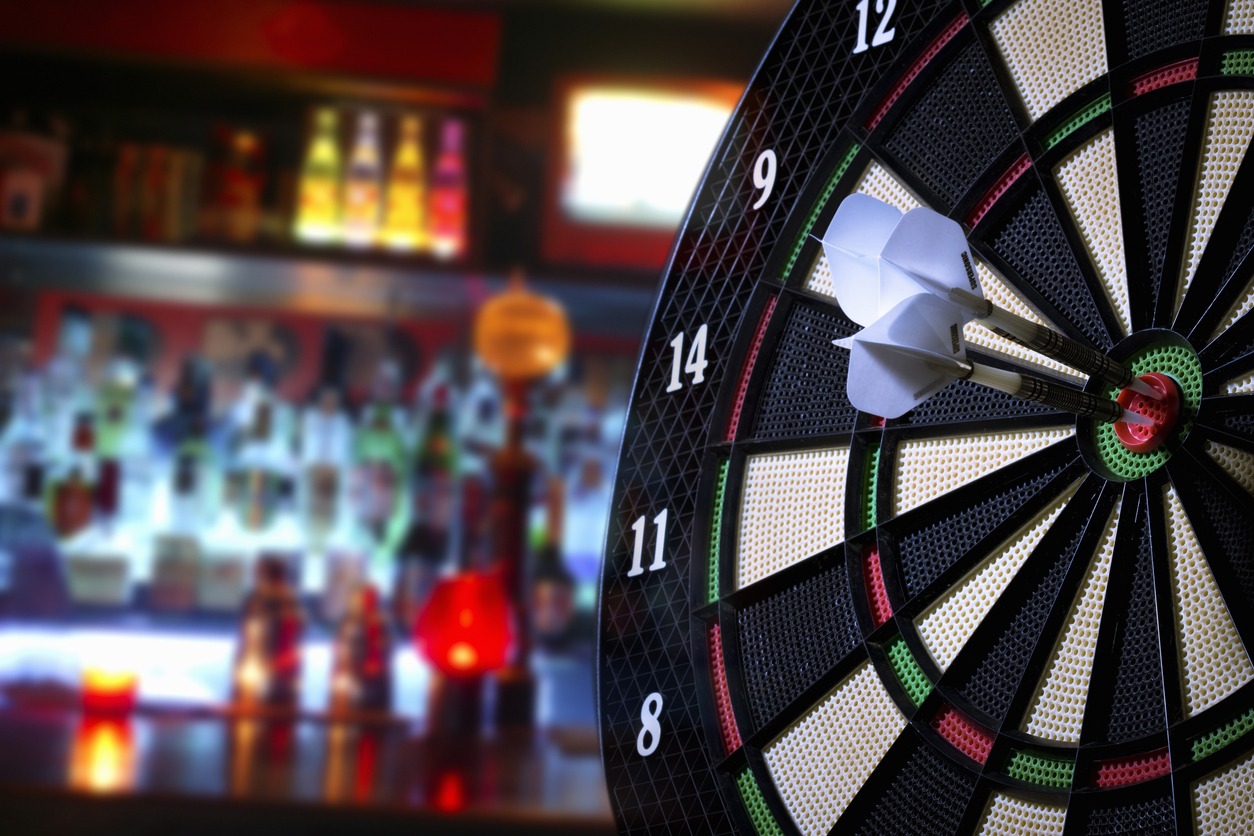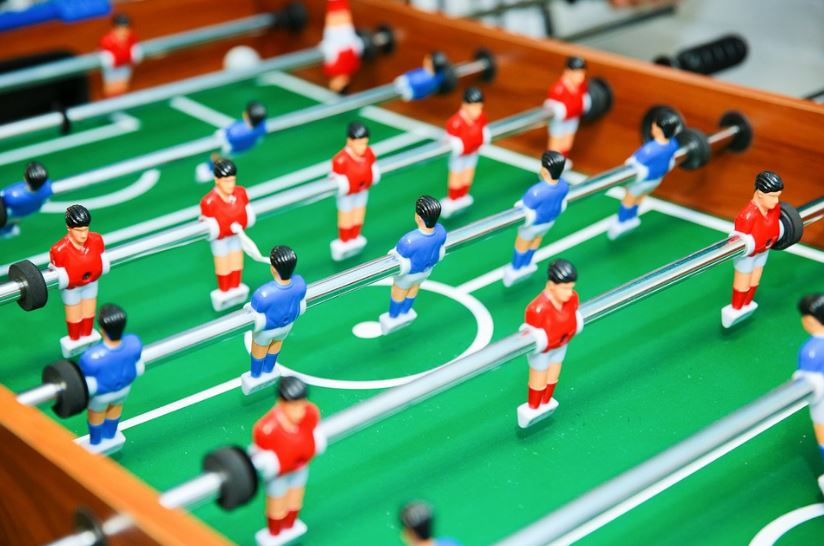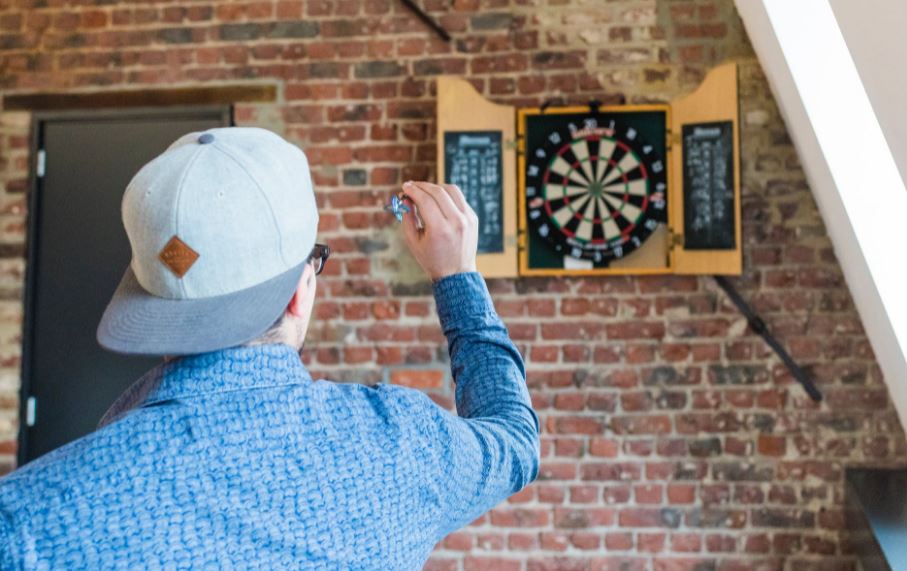Foosball vs. Darts: How to Choose the Right Game for Your Home Game Room
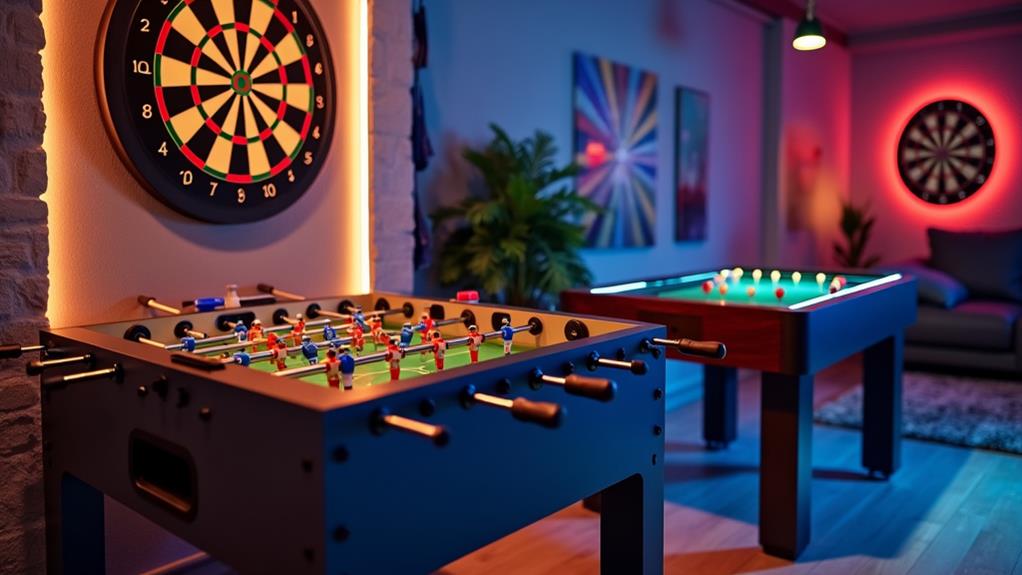
When choosing between foosball and darts for your home game room, consider your preferences for social interaction, space, and gameplay style. Foosball offers fast-paced, team-based action and requires larger playing space, making it great for lively gatherings. Darts, on the other hand, emphasize precision and skill, needing minimal setup space and providing a relaxed, conversation-friendly atmosphere. Budget-wise, both are affordable, but foosball tends to have higher maintenance costs. Think about safety too—darts require careful handling, while foosball needs space management to avoid injuries. Evaluating these factors will help you decide which game matches your needs perfectly. Investigate further to uncover specific details and recommendations.
Player Preferences
When selecting a game for your home game room, it's essential to take into account player preferences to guarantee everyone has a great time. If your group loves fast-paced action and strategic play, foosball is a fantastic choice. Its quick reflex requirements and team-based gameplay appeal to those who thrive on energetic, interactive experiences. Up to four players can engage simultaneously, making it a social hub in your game room.
On the other hand, darts might be more up your alley if you and your friends prefer skill-based challenges and precision. Darts can be played individually or in small groups, offering versatility for different social settings. This makes it ideal if your game room often hosts varying numbers of players. The laid-back nature of darts allows for casual conversations and a relaxed atmosphere, perfect for those quieter, more social gatherings.
Consider the maintenance aspects as well. Foosball tables need regular rod lubrication and surface cleaning, which can be a deciding factor for some. Darts, in contrast, require minimal upkeep, mainly involving board maintenance and dart tip replacements. Balancing these factors against player preferences will help you choose the perfect game for your game room.
Space Requirements
Space is a significant factor when planning your home game room. When weighing foosball against darts, consider their space requirements. A foosball table typically needs about 5 feet by 3 feet for comfortable play, plus extra room for players to maneuver. This setup can dominate smaller spaces, and you might need to reposition other furniture to optimize the playing area.
On the other hand, darts offer a more compact solution. You only need 5 feet of clearance in front of the dartboard for throwing, plus an extra 3 feet behind for player movement. Since a dartboard is mounted on a wall, it saves valuable floor space, making it ideal for tighter areas. Make sure your ceiling height is at least 7 to 8 feet for safety and comfortable play, as the standard dartboard height is 5 feet 8 inches from the floor.
Both foosball and darts require consideration of surrounding furniture and player traffic. Sufficient space for players and spectators to move freely without obstruction is vital for an enjoyable game night. Choose the game that best fits your room's layout and space requirements, guaranteeing your home game room is both fun and functional.
Cost Considerations
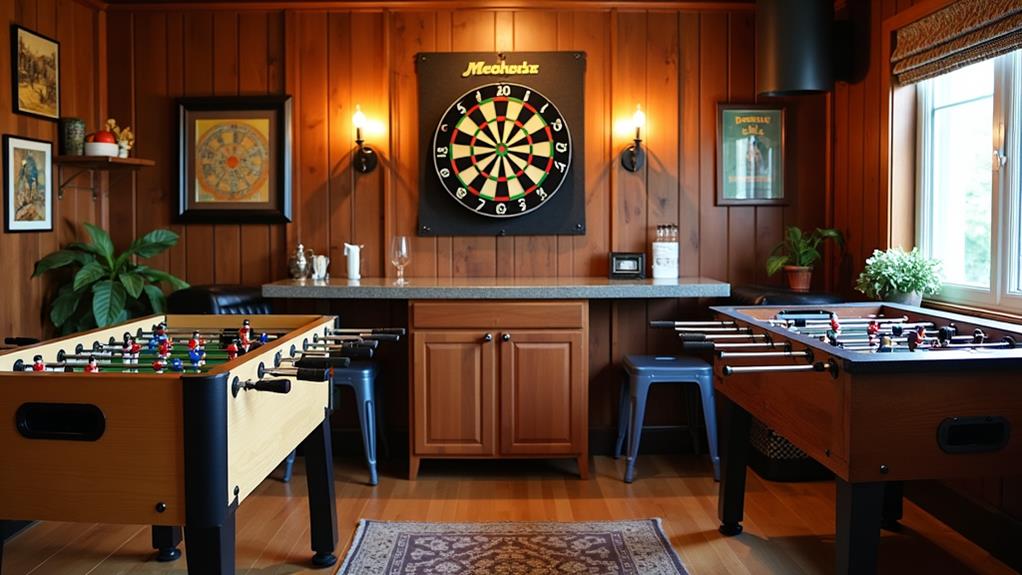
Wondering how much you'll need to spend on setting up your home game room? Regarding cost considerations, both foosball and darts present unique financial implications. A quality foosball table, such as the Kicker Foosball by Brunswick, can set you back around $499, with good options starting at $200. However, if you're aiming for a durable, high-performance table, expect to spend closer to $500.
On the other hand, darts is a more budget-friendly option. You can set up a quality table dart board for under $300. For instance, the Legacy Dart Cabinet is priced at $299 and offers a complete setup, including a sisal board and darts. This makes darts a cost-effective choice, especially if you're working with a tighter budget.
Maintenance costs also differ between the two. Foosball tables require rod lubrication and occasional part replacements, contributing to the long-term expenses. Dartboards might need new tips and periodic board surface replacements, but these costs are generally lower. Moreover, darts require less floor space, further reducing setup costs and making them ideal for smaller areas. Ultimately, your decision will hinge on balancing initial investment and ongoing maintenance against your available space and budget.
Gameplay Dynamics
Moving on from cost factors, let's explore the gameplay dynamics of foosball and darts. Foosball is all about fast-paced, strategic play requiring quick reflexes. Up to four players can engage in this soccer-inspired game, making it perfect for both casual and competitive settings. The scoring system is simple: get the ball into your opponent's net to score a goal. This straightforward approach fosters quick rounds and dynamic matches that keep everyone engaged.
On the other hand, darts focuses on precision and skill. Players aim at a circular board to score points, promoting focus and accuracy. Different game types like "501" or "Cricket" add variety to the gameplay, catering to both casual players and those seeking competitive tournaments.
Here are some aspects to reflect on:
- Foosball: Requires more space for movement and player maneuvering.
- Darts: Needs a safe area for throwing, suitable for more compact setups.
- Foosball: Up to four players can compete, enhancing social play.
- Darts: Varied game types offer different challenges and levels of complexity.
- Both games: Can be enjoyed casually or competitively, depending on your preference.
Understanding these gameplay dynamics will help you determine which game suits your home game room best.
Social Interaction

Incorporating foosball or darts into your home game room can greatly boost social interaction. A foosball table encourages fast-paced, energetic gameplay that naturally brings people together. Regardless of you're hosting a party or a casual get-together, foosball's dynamic action promotes lively conversation and friendly competition. Players often gather around the table, facilitating interaction and creating a colorful atmosphere.
On the other hand, a dart board offers a different kind of social experience. Darts requires precision and skill, fostering a competitive yet relaxed environment. As players take turns, there's plenty of time for conversation and camaraderie. The dart board becomes a focal point, drawing people in and encouraging them to engage in friendly matches. This makes darts an excellent choice for varied social gatherings, appealing to both seasoned players and beginners alike.
Both games are versatile and can accommodate different numbers of players and skill levels. Regardless of you choose a foosball table or a dart board, you'll be creating a lively, engaging environment in your home game room. Each game offers unique ways to boost social interaction, making your gatherings more enjoyable and memorable.
Maintenance Needs
While foosball and darts are fantastic for enhancing social interaction, it's crucial to take into account their maintenance needs to keep your game room in prime condition. Foosball tables, for example, require regular care to guarantee peak performance. You'll need to lubricate the rods periodically to keep them moving smoothly and prevent wear and tear on the mechanics. Dust buildup can affect gameplay, so a thorough cleaning of the table should be part of your routine.
Darts, on the other hand, come with their own set of maintenance requirements. The dartboard surface needs regular attention, including periodic replacement of dart tips to maintain play quality. Moreover, you must consider the space around the dartboard to avoid damage to surrounding areas, which means careful placement and upkeep of the setup.
Here are some crucial maintenance tips for both games:
- Lubricate foosball rods regularly
- Clean the foosball table to prevent dust buildup
- Replace dart tips periodically to maintain peak play
- Guarantee adequate space around the dartboard for safety
- Compare upkeep costs to manage your budget effectively
Safety Concerns
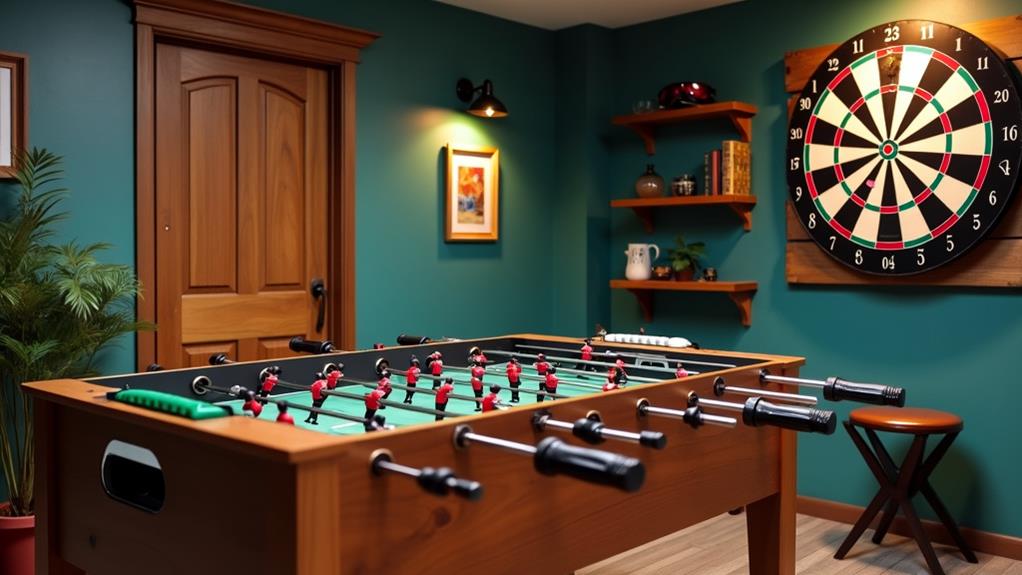
Safety is paramount while setting up a home game room. Regarding dartboards, safety concerns are significant due to the sharp tips of the darts. You need to install the dartboard at least 5 feet 8 inches from the floor and guarantee a clear area of at least 3 feet around it. This setup helps mitigate the risk of injury for both players and spectators. For added safety, consider using an electronic dartboard, which eliminates sharp tips and creates a safer environment, especially if you have children at home.
Foosball tables, while generally safer, aren't without their hazards. Fast-moving rods and hard plastic players can lead to pinched fingers, particularly for children or inexperienced players. Supervision is key to preventing accidents. Be sure to keep an eye on younger players and instruct them on how to play safely.
Both games require constant supervision to promote a safe playing environment. Darts can cause serious injuries if mishandled, while foosball can result in minor injuries like pinched fingers. By taking these precautions and maintaining supervision, you can create a fun and safe game room experience for everyone.
Longevity and Engagement
Having established a safe environment, let's investigate how to guarantee your game room remains engaging over the long term. Regarding longevity and engagement, both foosball and darts offer unique benefits. Foosball tables often maintain consistent engagement due to their fast-paced gameplay. Players of all generations and skill levels can jump into a game, making it a hit during gatherings. The social nature of foosball fosters a dynamic environment, keeping it popular in social settings.
On the other hand, darts demand precision and skill, which can lead to a steeper learning curve. This could affect long-term engagement as players might lose interest if their skills don't improve. However, a well-maintained dartboard can still offer lasting enjoyment if integrated into social activities effectively.
To guarantee your game room keeps everyone entertained, consider the following:
- Invest in high-quality game tables to ensure durability and long-term satisfaction.
- Regularly maintain both foosball tables and dartboards to keep them in top condition.
- Encourage social play to maximize engagement for both games.
- Mix up game types to cater to different skill levels and interests.
- Create mini-tournaments or challenges to keep the excitement alive.
Aesthetic Appeal
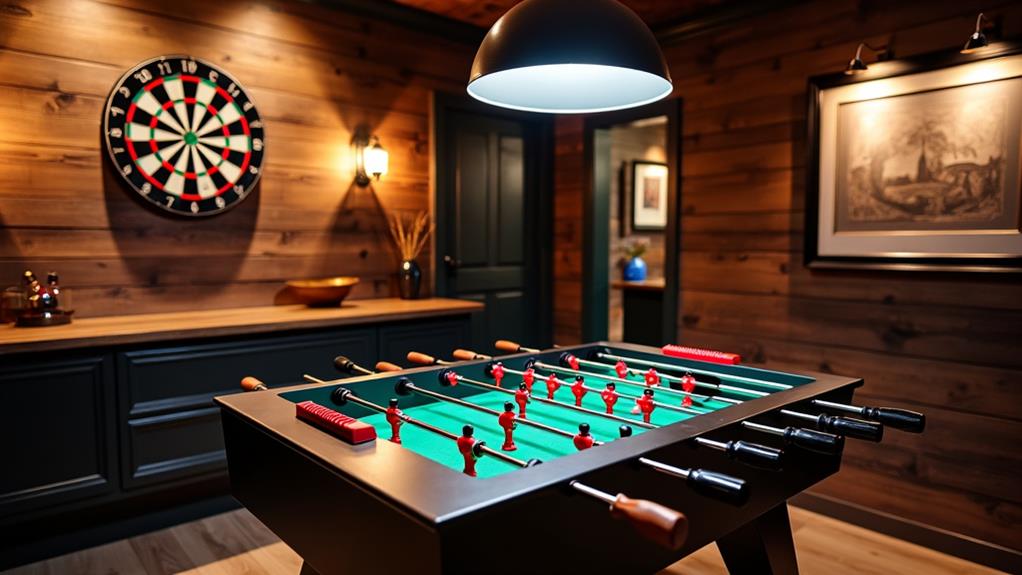
Aesthetic appeal plays a crucial role in setting the tone for your home game room. When choosing between foosball and darts, consider how each game improves the room's visual appeal. Foosball tables often feature sleek, modern designs with lively colors, making them a stylish addition to any decor. Their bold presence can act as a conversation starter and focal point during gatherings, instantly raising the room's atmosphere.
On the other hand, dartboards can be housed in elegant wooden cabinets that not only store the dartboard and accessories but also add a touch of sophistication to the space. Dartboards, especially those made from sisal fibers, provide a rustic yet refined look that complements different interior design themes. This can make them a versatile choice for multiple styles, from traditional to contemporary.
Both games offer customization options, allowing you to select colors and styles that perfectly fit your personal taste and room ambiance. Whether you lean towards the modern visual appeal of a foosball table or the classic aesthetic charm of a well-crafted dartboard, your choice will greatly impact the overall feel of your game room.

